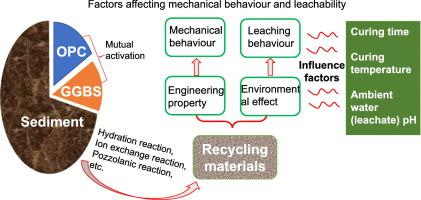当前位置:
X-MOL 学术
›
Sci. Total Environ.
›
论文详情
Our official English website, www.x-mol.net, welcomes your
feedback! (Note: you will need to create a separate account there.)
Dredged marine sediments stabilized/solidified with cement and GGBS: Factors affecting mechanical behaviour and leachability.
Science of the Total Environment ( IF 8.2 ) Pub Date : 2020-04-08 , DOI: 10.1016/j.scitotenv.2020.138551 Wan-Lu Zhang 1 , Lun-Yang Zhao 2 , Bryan A McCabe 3 , Yong-Hui Chen 4 , Liam Morrison 5
Science of the Total Environment ( IF 8.2 ) Pub Date : 2020-04-08 , DOI: 10.1016/j.scitotenv.2020.138551 Wan-Lu Zhang 1 , Lun-Yang Zhao 2 , Bryan A McCabe 3 , Yong-Hui Chen 4 , Liam Morrison 5
Affiliation

|
Management strategies for the safe disposal of contaminated dredged marine sediment constitute a global-scale environmental issue. The stabilization/solidification method was investigated as a sustainable approach to the recycling of the sediment as a construction material. A systematic study of the factors affecting the mechanical performance and contaminant release was performed. The physico-chemical variables selected to assess the potential re-use of the sediment treated with Ordinary Portland cement (OPC) and Ground Granulated Blast Furnace Slag (GGBS) in an aquatic environment were: curing duration (7, 28, 56 and 98 days), curing temperature (5, 20 and 40 °C) and ambient (leachate) pH (1, 4, 7 and 10). Unconfined compressive strength (UCS) tests were conducted and extended-duration tank leaching tests were used to characterize the long-term leaching of Al, Cr, Mn, Fe, Ni, Cu, Zn, As, Cd, Ba, Pb. The results showed that S/S methods provide excellent immobilization of metals in marine sediment at a pH range of 4 to 10. Immobilization efficiencies of >99.9% for Mn, Fe, Zn, As, Ba, Pb and >97.8% for Al, Cu and Zn are reported over 100 days. GGBS replacement is an effective way to further improve sediment properties by enhancing strength, mitigating sediment alkalization and offering a better immobilization capacity for Fe, Ni and Zn. The release of metals (Al, Mn, Cu, As, Ba and Pb) was strongly associated with a coupling effect of the physico-chemical factors, with metal-specific responses to curing temperature, curing duration and pH. Mn mobility showed a dramatic sensitivity to ambient pH while Ba was less pH-dependent. Al release is related to strength and leached out by dissolution in all situations considered. Considering that dredged marine sediments may contain multiple metal contaminants which exhibit individual responses to remediation, treatment with GGBS may be considered a potentially suitable management option.
中文翻译:

用水泥和GGBS稳定/固化的疏marine海洋沉积物:影响机械性能和浸出性的因素。
安全处置受污染的疏marine海洋沉积物的管理策略构成了全球性的环境问题。研究了稳定/固化方法,作为回收作为建筑材料的沉积物的可持续方法。对影响机械性能和污染物释放的因素进行了系统的研究。选择用于评估在水生环境中用普通硅酸盐水泥(OPC)和碎粒高炉矿渣(GGBS)处理的沉积物的潜在再利用的物理化学变量为:固化时间(7、28、56和98天) ),固化温度(5、20和40°C)和环境(渗滤液)pH(1、4、7和10)。进行了无侧限抗压强度(UCS)试验,并使用了延长寿命的罐浸试验来表征Al,Cr,Mn,Fe,Ni,Cu,Zn,As,Cd,Ba,Pb的长期浸出。结果表明,S / S方法在pH范围为4至10的情况下,能够很好地固定海洋沉积物中的金属。Mn,Fe,Zn,As,Ba,Pb的固定效率> 99.9%,Al,> 97.8%。据报道,铜和锌超过100天。GGBS替代是通过增强强度,减轻沉积物碱化并提供更好的Fe,Ni和Zn固定化能力来进一步改善沉积物特性的有效方法。金属(Al,Mn,Cu,As,Ba和Pb)的释放与物理化学因素的耦合效应密切相关,并且与金属对固化温度,固化时间和pH的特定响应有关。Mn的迁移率显示出对环境pH的显着敏感性,而Ba对pH的依赖性较小。在所有考虑的情况下,铝的释放与强度有关,并且通过溶解而浸出。考虑到疏marine的海洋沉积物中可能含有多种金属污染物,这些污染物会表现出对修复的单独反应,因此,GGBS处理可能被认为是一种潜在的合适管理方案。
更新日期:2020-04-08
中文翻译:

用水泥和GGBS稳定/固化的疏marine海洋沉积物:影响机械性能和浸出性的因素。
安全处置受污染的疏marine海洋沉积物的管理策略构成了全球性的环境问题。研究了稳定/固化方法,作为回收作为建筑材料的沉积物的可持续方法。对影响机械性能和污染物释放的因素进行了系统的研究。选择用于评估在水生环境中用普通硅酸盐水泥(OPC)和碎粒高炉矿渣(GGBS)处理的沉积物的潜在再利用的物理化学变量为:固化时间(7、28、56和98天) ),固化温度(5、20和40°C)和环境(渗滤液)pH(1、4、7和10)。进行了无侧限抗压强度(UCS)试验,并使用了延长寿命的罐浸试验来表征Al,Cr,Mn,Fe,Ni,Cu,Zn,As,Cd,Ba,Pb的长期浸出。结果表明,S / S方法在pH范围为4至10的情况下,能够很好地固定海洋沉积物中的金属。Mn,Fe,Zn,As,Ba,Pb的固定效率> 99.9%,Al,> 97.8%。据报道,铜和锌超过100天。GGBS替代是通过增强强度,减轻沉积物碱化并提供更好的Fe,Ni和Zn固定化能力来进一步改善沉积物特性的有效方法。金属(Al,Mn,Cu,As,Ba和Pb)的释放与物理化学因素的耦合效应密切相关,并且与金属对固化温度,固化时间和pH的特定响应有关。Mn的迁移率显示出对环境pH的显着敏感性,而Ba对pH的依赖性较小。在所有考虑的情况下,铝的释放与强度有关,并且通过溶解而浸出。考虑到疏marine的海洋沉积物中可能含有多种金属污染物,这些污染物会表现出对修复的单独反应,因此,GGBS处理可能被认为是一种潜在的合适管理方案。











































 京公网安备 11010802027423号
京公网安备 11010802027423号